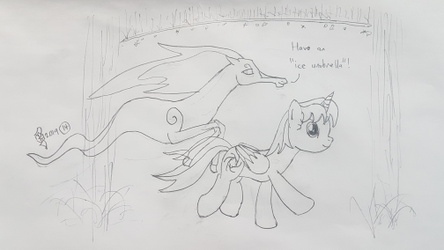Sign In
ClosePTSJ19 Day 15A: Kofun of Mozu by Parcly Taxel
Sweetie Belle: The mostly coda-free nature of the Japanese language (ん/N being the only phoneme of this type, though the vowel in word-final phonemes ending with U may be dropped in fast speech) makes it easy to write songs, such as those you might hear in a commercial. Those songs were what Parcly heard most of the time during her "morning hangover" after waking up.
Parcly Taxel: Some of these songs are rather absurd, either in nature or in lyrics. The phone number may occupy one or more whole lines of the music, which is less of a problem than in other languages because there are multiple ways to read a digit. I admit that listening to these bite-size ballads of problems and their resolutions and watching the accompanying graphics helped clear my mind of negative thoughts.
Spindle: Yet this was only the prologue. Having done the usual preparations, we first went to the wholesale markets at Kizu (木津) on the Osaka Metro. At the transfer station of Honmachi (本町) Parcly's first thought was that it housed a giant video screen longer than two train cars, but no, that screen actually lies in Umeda, albeit on the same line she travelled on after transferring.
Parcly: Just like the one we visited in Karoto, the majority of Kizu's stalls are dedicated to seafood and fruits. Cardboard boxes litter the place, marked with places of origin and dozens of grading schemes; clams and raw fishes are kept in polystyrene boxes and aerated or put on ice respectively. The vendors, many of whom have been doing business here for decades, sit idle beside manual calendars or maps of Japan, sometimes smoking a cigarette.
Their clientele is also skewed towards older ponies. Drab and narrow and fishy and packed, this was a landscape of the part of Japan who resisted modernisation for their own good.
Spindle: Continuing the parallel to the first lunch of our Kyushu trip, we had donburi filled with seafood of many types for lunch at a nearby corner shop, from salmon to sea urchin. An old couple were alone in preparing the food, and we waited a long while, but the flavours were worth it.
Parcly: Now we could go further outwards into the neighbouring city of Sakai (堺), an important port open to foreigners during the early Meiji (明治) period. From Daikokuchō (大国町) we went to Tennōji, transferring there to JR's Hanwa Line (阪和線) which took us to Mozu (百舌鳥), a rare example of a place name written with more kanji than kana. I had a brain freeze in waiting on the wrong platform, then rushing to the correct platform 8 only to just miss the waiting train; I eventually boarded the 14:08 train. (Only local trains serve Mozu.)
Cinnabar: There are no prerecorded announcements on less-ridden train services; it is then a living being speaking, which heightens the feeling of closeness and warmth onboard. At some stations the doors don't open automatically due to low anticipated traffic there, in which case a button must be pressed.
King Sombra: Scenes of suburban Osaka outside show a good number of examples of tetraphobia – 1, 2, 3, 5 – in situations where indexing is not critical. The on readings of 四 (four) and 死 (death) are the same, hence the fear, but it is not as prevalent here as in Hong Kong where some skyscrapers omit all of the forties, partly out of a desire to increase property value by having "higher floors".
Spindle: The main attraction of Mozu is a World Heritage Site consisting of several kofun (古墳) or burial mounds. By far the largest of them still standing is Daisen-kofun (大仙古墳), the one that is (generally believed to be) the tomb of the Emperor Nintoku (仁徳天皇), whose perimeter measures about 3 km and is a popular jogging track. The only hole in its outer moat, in the middle of its bottom edge, houses a place of worship.
Parcly: When I arrived there a random stallion was chanting mantras on the floor next to a locked gate; he left soon afterwards. The keyhole-shaped mound indicates that the buried pony was of high rank, with square and circular mounds as lesser honours. It was doubly significant that we visited on the former Emperor's Birthday, 23 December – even though officially it was no longer a public holiday, some businesses treated it like one and did not open. (The current Emperor's Birthday is 23 February).
Submission Information
- Views:
- 244
- Comments:
- 0
- Favorites:
- 1
- Rating:
- General
- Category:
- Visual / Traditional




